


|
Commenced:
|
01/01/1995 |
|---|---|
|
Submitted:
|
24/05/2012 |
|
Last updated:
|
15/10/2021 |
|
Location:
|
Clogher, Kilfenora, Co. Clare, IE |
|
Climate zone:
|
Cool Temperate |
(projects i'm involved in)
Project: Sailchearnach
Posted by Ute Bohnsack over 11 years ago
Stinging nettle is one perennial plant we have more than enough of on our smallholding. It likes damp soil - a constant in the West of Ireland - and elevated levels of phosphate and nitrogen which it finds in and around livestock paddocks and wherever significant amounts of nutrients accumulate such as near compost heaps or underneath nitrogen-fixing trees such as alders and alongside hedgerows.
I used to merely tolerate it in some areas as it is an important foodplant for the larvae of several butterfly species, with the Small Tortoiseshell and European Peacock being fully dependent upon it. But then I realized just how nutritious this plant is and that it can be recycled into an excellent feed supplement for our chickens. Some old poultry books make reference to using nettles as a feed supplement and indicate improved health, more eggs, larger eggs, and better-coloured yolks. But even though nettles grow in the chicken runs, the birds very rarely touch them, even if there is nothing else green left for them to pick, presumably because of the stinging hairs.
Boiling however tames this defence mechanism, as anyone who has eaten nettle soup or nettle puree can confirm.
So here's a quick way of making nettle "spinach" that can be incorporated into your chicken feed.
Put on a pair of tough gloves and strip the leaves from the bottom of the stalk upwards; the soft tip will break off. Don't use the tough part of the stalk as it will be hard to puree the tough fibres.
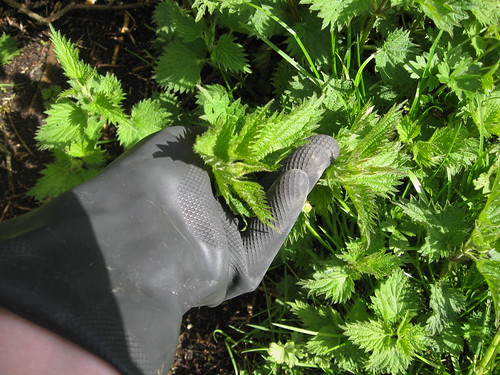
Fill a suitable container that can take boiling water. I usually fill the container below, tightly packed, resulting in about a pound of leaves and tips to add to the feed for around 50 birds. It only takes a few minutes.
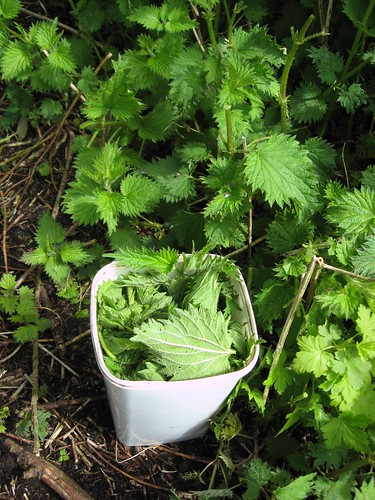
Fill the container with boiling water and let it sit for 5-10 minutes at least.
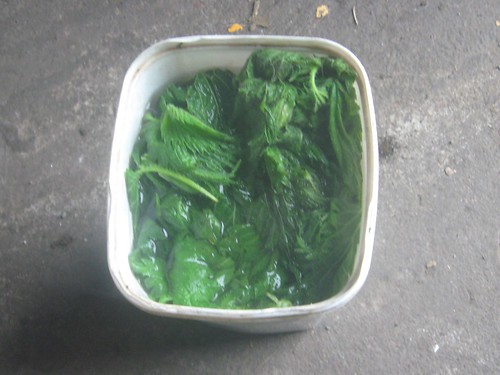
Using a stick blender blend until it resembles a course puree. CAUTION: I ruined a 400W stick blender (well, maybe I didn't and it would have broken anyway but it gave up when I was making this feed) so I moved on to a 700W one. It might also be possible to break the nettles down using manual implements such as those used for making wheatgrass and adding boiling water after but I have not tried that.
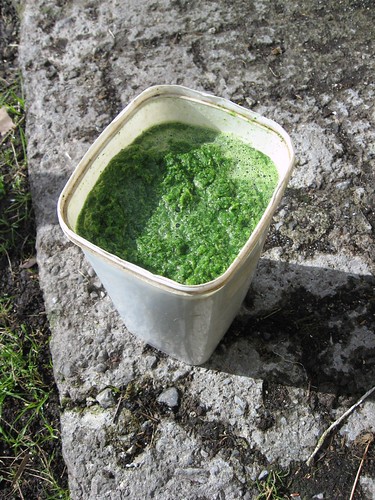
Add it to the ration. I mix it into the morning mash of organic pellets and wheat.
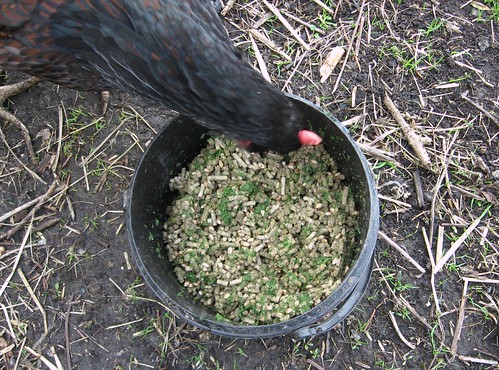
It gets Clara's approval. ;)
So what benefit do the chickens derive from nettles? Here is some nutritional info gleaned from the net (my emphasis).
"Wetherilt (1992) found the fresh leaves to contain 76.9% water, 1.6% fat, 6.5% protein, 4.1% nitrogen free extract, 5.3% fibre and 5.6% ash. This protein level corresponds to 28% on a dry matter basis." [...] "Wetherilt (1982) found 100 g fresh leaves (as is) to contain 0.015 mg thiamin, 0.23 mg riboflavin, 0.62 mg niacin and 0.068 mg vitamin B6. Analyses also revealed 238 mg vitamin C, 5 mg -carotene and 14.4 mg -tocopherol in 100 g of leaves. These are remarkably high values for these antioxidants with vitamin activities. [...] Nutrient analyses showed the leaves to be rich in minerals as well, especially with respect to the nutritionally important ones such as iron, calcium and potassium: iron (13 mg/100 g); zinc (0.9 mg/100 g); copper (0.52 mg/100 g); calcium (853 mg/100 g); phosphorus (75 mg/100 g); magnesium (96 mg/100 g); manganese (3 mg/100 mg); sodium (16 mg/100 g); potassium (532 mg/100 g); and selenium (2.7 g/100 g) (Wetherilt, 1992)."
Source: Wetheril, H. 2003 Nutritional evaluation of Urtica species, In: Urtica, The genus Urtica, Edited by Gulsel M . Kavalali CRC Press 2003 (http://www.crcnetbase.com/doi/abs/10.1201/9780203017920.ch6)
"Nettle is nutritionally high in vitamins A, C and D, also minerals iron, manganese, potassium and calcium. It contains 21-23% crude protein and 9-21% crude fibre.
As a feed component the quality of nettle plants is valuable. At the vegetative stage plants contain 4% protein and fibre, 50 microg/g carotene, 4 microg/g riboflavin and 10 microg/g vitamin E. By incorporating nettle into poultry feed it is possible to increase protein intake by 15-20% and vitamin intake by 60-70%, also green feed requirements can be reduced by 30%."
Source: http://www.ienica.net/crops/nettle.htm
It is of course also possible to dry nettles when they are in season and save them for the winter and indeed nettle hay is also a valuable feed supplement for other categories of livestock.
So even though it is difficult to take the sting out of the cost of poultry feed, you can take the sting out of nettles and use this free and often abundant, highly nutritious resource to replace a part of the proprietary feed.
But don't forget to leave some for the butterflies.
You must be logged in to comment.





Note: The various badges displayed in people profiles are largely honesty-based self-proclamations by the individuals themselves. There are reporting functions users can use if they know of blatant misrepresentation (for both people and projects). Legitimacy, competency and reputation for all people and projects can be evidenced and/or developed through their providing regular updates on permaculture work they’re involved in, before/after photographs, etc. A spirit of objective nurturing of both people and projects through knowledge/encouragement/inspiration/resource sharing is the aim of the Worldwide Permaculture Network.
 |
MemberA member is a permaculturist who has never taken a PDC course. These cannot become PDC teachers. Members may be novice or highly experienced permaculturists or anywhere in between. Watch their updates for evaluation. |
|---|---|
  |
Permaculture MatchmakerOne of these badges will show if you select your gender and the "I'm single, looking for a permaculture partner" option in your profile. |
 |
PDCPeople who claim to have taken a Permaculture Design Certificate (PDC) course somewhere in the world. |
 |
PDC VerifiedPeople who have entered an email address for the teacher of their PDC course, and have had their PDC status verified by that teacher. Watch their updates for evaluation. |
 |
PRI PDCPeople who’ve taken a Permaculture Research Institute PDC somewhere in the world. |
 |
PDC TeacherPeople who claim to teach some version of PDC somewhere in the world. |
 |
PRI TeacherWith the exception of the ‘Member’ who has never taken a PDC, all of the above can apply to become a PRI PDC Teacher. PRI PDC Teachers are those who the PRI recognise, through a vetting board, as determined and competent to teach the full 72-hour course as developed by Permaculture founder Bill Mollison – covering all the topics of The Designers’ Manual as well as possible (i.e. not cherry picking only aspects the teacher feels most interested or competent in). Such teachers also commit to focussing on the design science, and not including subjective spiritual/metaphysical elements. The reason these items are not included in the PDC curriculum is because they are “belief” based. Permaculture Design education concerns itself with teaching good design based on strategies and techniques which are scientifically provable. PRI PDC Teachers may be given teaching and/or consultancy offerings as they become available as the network grows. |
 |
Aid WorkerThe individual with this badge is indicating they are, have, or would like to be involved in permaculture aid work. As such, the individual may or may not have permaculture aid worker experience. Watch their updates for evaluation. |
 |
ConsultantThe individual with this badge is indicating they are, have, or would like to do paid permaculture design consultancy work. As such, the individual may or may not have permaculture consultancy experience. Watch their updates for evaluation. |
 |
Community ProjectCommunity projects are projects that help develop sustainable community interaction and increase localised resiliency. |